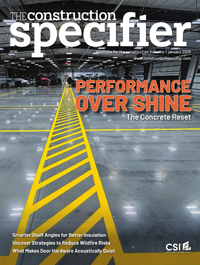Maintaining continuity: Keeping air/moisture barriers continuous at movement conditions

by John Chamberlin
At this point, most design/construction professionals have a pretty good understanding of the need for well-designed air and moisture control layers in wall assemblies. Water-resistive barriers (WRBs) have been in use for decades; in more recent years, a number of new systems have popped up that combine these products with an air barrier function, effectively creating ‘air and moisture barriers’ as the gold standard, if not the new norm.
Aside from simply keeping liquid water on the exterior of the building where it belongs, air and moisture barriers help reduce unwanted air movement through a building, which, in turn, lowers unnecessary energy consumption, helps prevent mold and mildew growth on the interior, stops pollutants such as radon gas and allergens from entering the building, and improves indoor occupant comfort by reducing drafts and external noise. Since air movement is also the primary source of condensation and moisture damage inside the wall cavity, an air and moisture barrier system also helps reduce structural degradation by keeping out water in both liquid and vapor forms.
If these benefits are not enough motivation in their own right, most states have adopted requirements for continuous air and moisture barriers either in their commercial, residential, or energy conservation codes (or a combination thereof). Understanding the benefits and the requirements are the first steps toward ensuring all buildings constructed include these critical systems in their design.
The proof of concept already exists as continuous air and moisture barriers systems have been in place long enough one can now see the positive long-term effects they have on buildings and their occupants, and a number of studies have been done to support this.1 However, as with so many things, reality may be more complicated than theory. The most important criteria for air and moisture barriers systems is for them to be continuous around the entire building. This continuity is where special attention and consideration needs to be given.
Buildings move
That buildings experience a degree of movement is something that must be taken into account and designed around, depending on the project’s climate zone and the materials comprising it. While this is not new information, it is still important to be aware that for a variety of different reasons, buildings (or their components) will continue to move as long as the structure is standing.
In looking at the causes for building movement, certain recurring themes emerge. Moisture is a major cause for building movement as it causes materials to degrade more quickly. Further, building components made from wood, stone, concrete, and brick expand and contract depending on their moisture content and temperature variations.
The ground on which buildings stand may also be prone to shifting or settling. Subsoil movement may be a result of expansion and contraction of the soil due to changes in moisture content. Some soils may experience shear or loadbearing failures, or any number of other external factors may cause the ground to move resulting in the slight shifting of buildings.
Building movement is accounted for with construction elements like masonry control joints. However, certain elements of the building move separately from adjacent elements—frequently manifesting as movement in areas such as where foundations meet walls, where walls meet doors and windows, where different wall systems meet, where different substrate materials meet, and at movement joints such as masonry control joints and floor line deflection joints.
This leads to an important question: “If we know our air and moisture barrier systems need to be continuous, and we know that buildings move, how do we ensure continuity of our air and moisture barriers systems and conditions where movement occurs?”
Pinpointing the problem
In 2010, at the National Institute of Building Sciences’ (NIBS’) Building Enclosure Science and Technology (BEST) 2 conference in Portland, Oregon, Peter Poirier and Brian Stroik presented a paper on eliminating the potential for air and moisture infiltration at the window-wall interface.2 The window-wall interface is an excellent example of a critical detail where special attention needs to be given not only to the materials used within the air and moisture barrier assemblies, but also to how those materials and assemblies perform over a long period given the building does not exist in a static environment.
In the paper, Poirier and Stroik pointed to a number of conventional methodologies used to determine whether or not a material is appropriate for use in an air and moisture barrier assembly. The first standard mentioned by the duo—ASTM E2357, Standard Test Method for Determining Air Leakage of Air Barrier—is frequently used by building product manufacturers as an initial way to validate their air barrier systems. The test looks at performance of assemblies applied to an opaque wall, as well as a wall with numerous pre-defined penetrations such as windows, electrical boxes,
and pipes. While this test does a good job of determining compatibility of the different components within the assembly, it does not address real-life site conditions or construction practices, and it does not account for movement of the building.
To account for building movement, Poirier and Stroik pointed to the 2009 International Energy Conservation Code (IECC); in Chapter 5, “Commercial Energy Efficiencies: Sealing of the Building Envelope,” it states:
openings and penetrations in the building envelope shall be sealed with caulking materials or closed with gasketing systems compatible with the construction materials and locations. Joints and seams shall be sealed in the same manner or taped or covered with a moisture vapor-permeable wrapping material. Sealing materials spanning joints between construction materials shall allow for expansion and contraction of construction materials.
Armed with some guidance regarding how materials should perform, and what is expected of them in the service of the building, the next step is to explore some of the most commonly used products for these applications.






